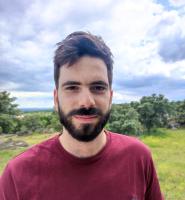Bengochea Paz Diego
- Investigador Postdoctoral
- Departamento: Biogeografía y Cambio Global
- Dirección física: C/ Abascal 2, 28006, Madrid
- Email: diego.bengochea@mncn.csic.es
- Número ORCID: 0000-0002-0835-3981
- Palabras clave:

Investigación
Initially trained as a statistical physicist (BSc and MSc), over time my interests drifted to biological physics and ultimately ecology. I eventually pursued a doctoral degree in Theoretical Ecology, within the Theoretical and Experimental Ecology Station of the CNRS (Moulis, France), where I investigated the coupled dynamics of human populations and managed landscapes from a theoretical and modelling perspective. My doctoral work contributed to characterize how the interplay between spatial landscape dynamics and human management practices determine sustainability in human-natural systems.
Following my PhD I worked for 2 years as a postdoctoral researcher within the Artificial Intelligence for the Environment and Sustainability (ARIES) team of the Basque Center for Climate Change (BC3). During my appointment I actively participated to the development of the k.LAB software stack for semantic modelling and its sustainabiltity-oriented children platform ARIES: an AI-powered open-source platform for the integration and interoperability of multidisciplinary models and data. My contributions were focused on the development and implementation of state-of.the-art modelling techniques within the platform with a special focus on complex networks for ecosystem service modelling. I participated in the 2023 United Nations Big Data Conference and Hackaton as a lecturer in a workshop on the use of ARIES platform for Natural Capital Accounting. I also participated in a consultancy for the WorldBank where we produced global carbon stock maps from 2000-2020. Finally, I worked on the development of climate-based and parsimonious modelling workflows for large-scale ecological mapping, with a special focus on modelling carbon stocks.
During my current postdoctoral appointment at the MNCN, I will pursue my work on the modelling of the carbon cycle. Specifically, I will integrate animal community dynamics in carbon cycling models to understand and quantify how animal biodiversity shapes carbon fluxes and contributes to the carbon storage in the soils. The results from my research will be applied to the production of more accurate maps of carbon stocks and fluxes that will be used as a basis for the design of conservation policies by the Spanish government.
Otros investigadores del departamento
- Rey Simo Ana
- Acuña Míguez Belén
- Álvarez Hugo Alejandro
- André Ferreira Mira
- Aragon Carrera Pedro
- Bastos Araújo Miguel
- Benítez López Ana
- Bravo-Oviedo Andrés
- Camacho Luis
- Concepción Cuevas Elena Daniela
- Diaz Esteban Mario
- Galiana Ibañez Nuria
- Godefroid Martin
- Gómez-Vadillo Mónica
- González Trujillo Juan David
- González Ximénez de Embún Miguel
- guim.ursul
- Herrando Pérez Salvador
- Hortal Joaquín
- Jiménez Valverde Alberto
- LoboJorgeM
- Matias Miguel
- Mendoza Manuel
- Merino Robert Nicolàs
- Mingarro López Mario
- R. Pertierra Luis
- Rausell Moreno Armand
- Ronquillo Ferrero Cristina
- Sánchez Albert Adrián
- Tarjuelo Mostajo Rocío
- Valladares Ros Fernando
- Wilson Robert J.
- Zarzo Arias Alejandra





